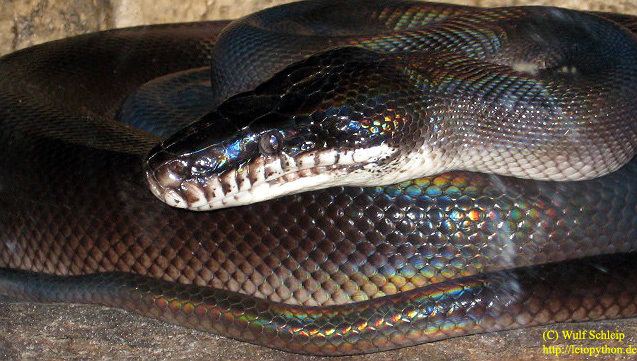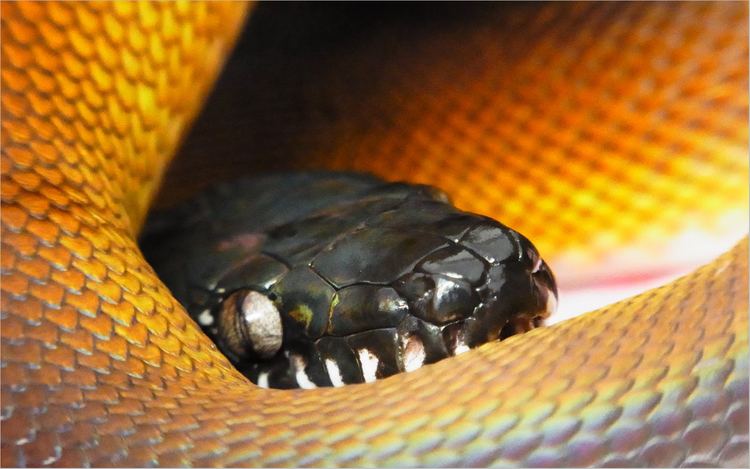Suborder Serpentes Phylum Chordata Rank Genus | Subphylum Vertebrata Scientific name Leiopython Order Scaled reptiles | |
 | ||
Lower classifications Bismarck ringed python, D'Albertis' python | ||
My white lipped pythons leiopython albertisii 2012
Leiopython is a genus of nonvenomous pythonid snakes, which currently comprises six species. It was formerly a monotypic genus created for the species L. albertisii, found in New Guinea.
Contents
- My white lipped pythons leiopython albertisii 2012
- White lipped python leiopython albertisii
- Species
- Description
- Behavior
- Geographic range
- Habitat
- Feeding
- Reproduction
- Taxonomy
- References

White lipped python leiopython albertisii
Species
The genus includes the following species:

Description

Female adults of the northern white-lipped python (Leiopython albertisii) grow to an average of about 213 cm in length (6–7 ft), whereas the southern white-lipped python can reach up to 300 cm (9.8 ft) in length. They are patternless, except the northern white-lipped python has some light markings on its postoculars, which are absent in the southern white-lipped python. The snout is triangular and the head is distinct from the neck. The dorsum of the head is shiny black, the upper and lower labial scales are white with black markings on the anterior edge of the scales. Body color is either brownish-violet fading to yellowish ventrally (L. albertisii) or blackish-blue fading to gray. These pythons occasionally regurgitate fur balls, or castings, a few days after feeding on a furred prey item.
Behavior

Although mostly terrestrial, these snakes can and are known to occasionally climb. White-lipped pythons are reportedly aggressive, though this is reduced in those born and raised in captivity. These snakes have also been observed to regularly regurgitate fur balls from their prey.
Geographic range

These snakes are found in most of New Guinea (below 1200 m), including the islands of Salawati and Biak, Normanby, Mussau and Emirau, as well as a few islands in the Torres Strait.
The type locality given is "Kapaor in Nova Guinea boreali occidentali ... et prope Andai ". The authors also stated localities for two additional specimens: "... un esemplare a Kapaor fra i Papua Onin..." and "... un secondo esemplare ad Andai presso Dorei..." (Kapoar, Onin Peninsula and Andai, near Dorei, Irian Jaya, Indonesia).
Some doubt can be cast on its occurrence on Normanby, as McDowell (1975) had erroneously assigned Bara Bara to this island, rather than to the mainland of Papua New Guinea in Milne Bay Province as stated by Boulenger (1898) and Koopman (1982).
Habitat
Associated with rain forests, cutover clearings and swamps, they are usually found near water, into which they may quickly retreat if disturbed. They often hide under dead leaves on forest floor.
Feeding
The diet includes a range of small- to medium-sized birds and mammals. Neonates and juveniles often feed on lizards. Heat sensitive pits in the upper and lower jaws are used to help locate prey during nocturnal hunting.
Reproduction
The oviparous females lay about a dozen eggs. The eggs stick together in a compact pile, and the females coils around them. The hatchlings emerge after about two months of incubation and are about 38 cm (15 in) in length.
Taxonomy
A new species L. hoserae, and two new subspecies L. albertisii barkeri and L. a. bennetti, were described in Hoser (2000), but these descriptions are considered vague and questionable. In 2008, Schleip redescribed and provided proper descriptions and diagnoses for two of Hoser's (2000) taxa, Leiopython hoserae, from the southern lowlands of Papua New Guinea and neighbouring Indonesia, and L. benettorum, from the highlands of Morobe Province, Papua New Guinea. A third, Leiopython albertisii barkeri was considered a nomen nudum due to Hoser not having provided a description that includes characters to differentiate this taxon from others. Three new species were also described: L. biakensis from the island of Biak (part of the Indonesian Province of Papua, L. fredparkeri from the Karimui Basin, Simbu Province, Papua New Guinea, and L. huonensis from the Huon Peninsula, Morobe Province, Papua New Guinea.
The taxonomy of the family Pythonidae is fluid; however, an arrangement of the genus may be summarised as:
(* The specific name, bennettorum, is genitive plural because it is in honor of two unrelated zoologists named Bennett: Clive Bennett, and Daniel Bennett.)
